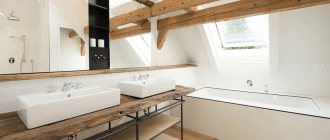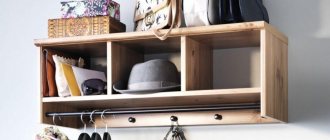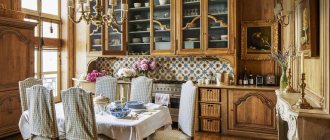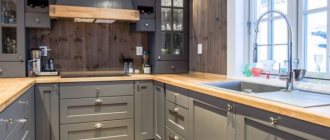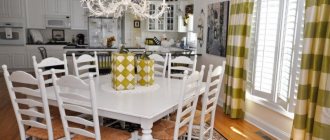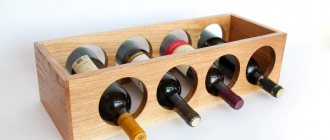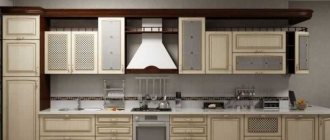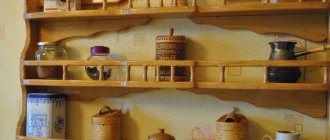For true connoisseurs of European cuisine, not a single meal is complete without a glass of expensive wine. This drink has long gained wild popularity and still does not give up its leading position. Such a noble product requires a special approach to its storage. Many true connoisseurs collect very valuable and rare specimens in their collections.
Today we're sharing 13 amazing DIY ideas for decorating wine racks in your home.
Differences from a wine cabinet
A cabinet is a more bulky and functional product that allows you to create certain storage conditions. Modern cabinets allow you to regulate temperature and light, simulating the conditions of a wine cellar.
Protects against drying out of plugs, third-party odors, exposure to ultraviolet radiation and temperature changes.
The wine rack in the kitchen has a slightly different purpose:
- An important element of the interior.
- Storing wine bottles horizontally. This is the position in which wine should be stored.
- Protection from constant shaking and direct sunlight.
- Convenient systematization of alcoholic drinks. A particularly important function for people who collect alcohol.
The shelf, unlike the cabinet, also performs a demonstrative function. The owner can always elegantly demonstrate the rare or expensive wines in his collection.
Why is wine stored horizontally ↑
It is customary to store wine in a horizontal position so that the cork is in contact with the drink. Wine shelves are positioned at an angle of 15०. This is exactly the slope that is observed in professional storage facilities. But not all wine racks can boast of such shelves, it is not always possible to achieve the desired tilt, and the horizontal position is just a way out of the situation, a compromise.
There are two common versions of the "wet plug":
- evil oxygen will penetrate into the bottle if the cork dries out and spoil the wine;
- a dry cork will crack, and its pieces will spoil the wine.
Oxygen contact version ↑
Oxygen is not on the list of enemies of wine - a good half of vintage wines desperately need it. But everything is good in moderation and on time.
Ports, sherries, Muscat Rutherglen and Topaque (Australian Tokay), sweet French wines “build” their bouquet in collaboration with oxygen. Some table wines also require it. Notes of nuts, dried fruits, honey, wax, characteristic sherry notes are the result of oxidation.
Madeira is generally out of the ordinary - in addition to oxygen, this wine requires heating.
Wine bottles
Much depends on the grape variety - if Grenache is susceptible to oxidation, then Sauvignon and Shiraz, on the contrary, are prone to reduction (reduction is the reverse process of oxidation). Wine from such varieties, sealed with a screw cap (which excludes contact with oxygen), acquires the smell of rotten eggs or cabbage.
Madame Clicquot turned the bottles over so that the sediment settled on the cork, it could be removed and a clear sparkling wine would be obtained. In the case of champagne, the problem of contact with oxygen was not even close - the carbon dioxide rushing out will not allow air to penetrate into the bottle (and the air is not under pressure after all).
Wine in bottles
After a couple of decades of storing wine, the cork becomes waterlogged. Wine (not all, but a lot of it, Burgundy for sure) needs to be re-corked. Famous winemakers provide this service free of charge.
The wine is opened a couple of hours before serving - it is left to breathe and become saturated with oxygen. Only a small part of the wines will be satisfied with the air entering through the neck of the bottle - the rest must be poured from glass to glass, since the contact zone with oxygen is too small (!).
The drink is saturated with oxygen not only before serving, but also when it is kept. For example, Rutherglen Muscat is slowly transferred from cask to cask - this is the correct aging process. Oxygen also enters through the pores of the wood. But the barrels are lying there!
Wine barrels
Cracked cork version ↑
Globally, 3–5% of wine suffers from TCA (Trichloranisol). TCA is a waste product of mold fungi. Their spores settle in the pores of the cork and cannot be disinfected. Once the pores are disturbed (and they are closed), TCA will cause “cork disease” in the wine - the drink will acquire a musty, moldy smell. It’s really better for the cork not to crack.
Natural cork is the result of a centuries-long search for the ideal. It turned out to be universal - suitable for fortified, table, and sparkling wines. The cork protects the wine from many troubles, and the wine protects the cork.
If you decide to store wine in the kitchen, follow the rules, get a wine cabinet and don’t forget to check with the seller what exactly your wine needs.
Classification of wine shelves
The wine rack is not only functional, but also an important stylistic element. Therefore, manufacturers offer various design options for such furniture.
You can also build a shelf yourself using wood or chipboard. This allows you to create a unique set for the individual needs and characteristics of the room.
By type of design
The most common option is a cantilever design. The shelf is made in the form of a straight horizontal surface. Usually mounted on the wall using “corners”.
It is desirable that the design include back and side panels to protect the bottles from negative factors. The shelf may have one or several tiers.
Based on the location of the shelves, they are divided into the following types:
- Singles;
- Group.
For small quantities of wine, a single shelf is usually used, especially if the room is compact. Group products are suitable for storing a large number of bottles.
They are a kind of functional and decorative composition, consisting of separate parts made in the same style. However, the dimensions and number of compartments of individual shelves may vary.
By location
Manufacturers provide the opportunity to buy wine racks in the following types of arrangement:
- Vertical. The optimal choice for a small kitchen. The bottles are arranged vertically, so they do not take up much space.
- Horizontal. For larger spaces. But the length should be short, otherwise the shelf will take up an irrational amount of space. Most often they buy shelves for storing 4-6 bottles.
- Diagonal. A classic version in the form of a compact wooden lattice.
- Inclined. They allow bottles to be positioned at a certain angle to preserve the consumer properties of wine during storage.
- Combined. They can contain compartments for horizontal and vertical storage of bottles at the same time.
Built-in wardrobes
Obviously, one of the most convenient and attractive ways to store your wine collection is to integrate special shelving into the finished space. This way you don't have to look for extra space in your kitchen. The Room Interiors portal suggests equipping a regular sideboard for dishes with shelves. Thus, in one half you can store drinks, and in the other, sets of glasses and cutlery.
Another option, equipped in a kitchen unit. All you need is to equip one of the modules with special compartments and a grille, as the designers from Live Laugh Decorate did.
The following DIY project will appeal to those whose kitchen space is so limited that it seems impossible to allocate even a little free space. You can get a small vertical shelf. It is very narrow and therefore will not take up too much space, and you can vary the height yourself. If desired, you can make it from the floor to the ceiling.
A stunning wine rack option. All you need is to make a few round holes in the plywood sheets and fasten them together. This shelf can be used as a partition to divide space. If you paint the inside in an unusual color, it will become a stylish and fashionable interior detail.
Manufacturing materials
Wooden wine racks are considered the most aesthetically attractive, practical and reliable. Dimensions, color and shape do not change during operation.
Wood, as a rule, has a varnish coating for decoration and protection from negative factors. The material does not heat up in the sun, so the properties of drinks are better preserved.
- Plastic models are quite popular.
- They are widely used due to their affordable cost and variety of forms.
- But, during operation, they can change color from ultraviolet radiation and become deformed due to storing a large number of bottles.
Glass products are the least popular due to the fragility of the material. Glass is often damaged during the cooking process and can deteriorate due to temperature fluctuations, which is important for the kitchen area.
You can purchase a model made of impact-resistant tinted glass, but such products have a relatively high cost.
Pipes
The idea may seem strange, but a wine bottle perfectly follows its cylindrical shape. So why clutter the space with a million shelves and racks when wine can be stored in space-saving tubes of the right size? For example, equip the cellar with a wall made of cylindrical building blocks. Now they can be purchased at any hardware store. A terracotta clay tube creates an ideal microclimate for storing a delicate and capricious drink.
Turn your wine rack into a real work of art! A budget alternative to brick blocks will be durable PVC pipes. Create an amazing composition from elements of different diameters, just like the Adventures in Creating designers did.
Drainage pipes are also great for storing your favorite wines. The main thing is to firmly fasten them together, then your drinks will be completely safe. Adventures of an Almost 40 Year Old Intern also suggests equipping a kind of coffee table at the top of the structure. This will create an additional surface for placing things or accessories.
If you are looking for the simplest and most economical option, then you won’t find anything better than a shelf made from cardboard mailing tubes. Agree, this project from Bob Vila looks very original and worthy of attention!
Design and colors
It is important that the design of the shelf is in harmony with the overall design of the interior. The most popular classic option is dark-colored wooden shelves. This design evokes associations with a full-fledged wine cellar.
Wooden products fit well into interior styles such as Provence, country, loft and the like. For styles such as Scandinavian and rustic, it is better to select products in lighter colors.
Models with elements made of plastic and glass are well suited to modern styles - minimalism, hi-tech, loft and the like. Modern design is characterized by practicality and a minimum of decor. Metal products also fit well into such interiors.
Indoor location
As you can see in the photo of wine racks in the kitchen, when choosing a location, you need to take into account not only aesthetics, but also storage conditions. Wine must be protected from temperature fluctuations and ultraviolet radiation.
It is extremely important to take into account the storage conditions of the drink, otherwise it may lose its taste and aroma.
When choosing an installation location, you should consider the following requirements:
- Do not place it near the door or countertop. In these places, mechanical influences are possible, including vibration from the door and during cooking, which negatively affects the taste. The product must be at rest.
- The place should be protected from direct sunlight.
- Do not install near heat sources: stove, heating radiators.
- Free air circulation.
- A place with minimal risk of accidentally touching the set, including when using other furniture and kitchen equipment.
If the kitchen is small, it is optimal to mount a shelf on the wall above the dining table. The shelf should not be located too low or high.
It is best to install it at a height of average height. If the room is spacious, you can allocate a separate area for arranging an alcohol storage system.
Self-installation of a wine rack
Having the necessary tools and fastening materials, you can easily install a wine rack with your own hands.
To secure the shelf to the wall, you will need the following tools:
- Hammer or drill (depending on the wall material);
- Drill of suitable diameter;
- Fastening elements: fillers and screws;
- Marker or pencil for marking;
- Level for leveling furniture.
Factory-made shelves often come with installation instructions. If there is one, it is highly recommended to study it. There may be various subtleties depending on the design, materials and fasteners used.
Typically, a wine rack is installed in several stages:
- Fitting. Simply attach the assembled product to the wall.
- Marking locations for making mounting holes.
- Preparing holes. It is important to use a drill whose size matches the diameter of the dowels.
- Attach the structure to the wall and secure with self-tapping screws.
Usually fasteners are included in the kit. If they are not available, you should select screws and dowels of suitable sizes.
You should not use fewer fasteners than those provided by the manufacturer, as this may negatively affect the reliability of the structure.
Wall racks
Not everyone is lucky enough to have extra space for a built-in wine rack. However, everyone will definitely have a free wall. So why not use the empty space for a minibar? This project from Shanty 2 Chic was brought to life using a few pieces of wood and large hex screws. Light wear and marked title stickers give the shelf an elegant look, turning it into an antique piece.
An unusual option is offered by the designers of Hart's Desire Photography. This wooden shelf allows you to store your drink at an angle of 45 degrees. It looks a little dangerous, but in fact, the design is very reliable!
If you prefer versatility and multifunctionality in everything, then the project from The Kurtz Corner is what you need! By attaching special threaded trays to a regular hanging box, you will accomplish two tasks. This will be a shelf for storing both wine and glasses.
Our next idea comes from Erin's Lane/Etsy. Everything is extremely simple: all you need is a massive wooden board and a few cast iron bolts from the railway. Combine all this and you have a rustic wine rack in your home! A quick but very stylish DIY project.
